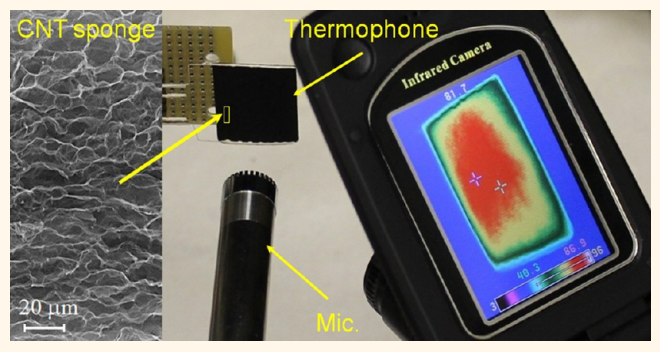 Ali E. Aliev, Nathanael K Mayo, Monica Jung de Andrade, Raquel O. Robles, Shaoli Fang, Ray H. Baughman, Mei Zhang, Yongsheng Chen, Jae Ah Lee, and Seon Jeong Kim
Ali E. Aliev, Nathanael K Mayo, Monica Jung de Andrade, Raquel O. Robles, Shaoli Fang, Ray H. Baughman, Mei Zhang, Yongsheng Chen, Jae Ah Lee, and Seon Jeong Kim
A.G. MacDiarmid NanoTech Institute, University of Texas at Dallas, Richardson, TX, 75083, USA
High-Performance Materials Institute, Florida State University, Tallahassee, FL, 32310, USA
Institute of Polymer Chemistry, College of Chemistry, Nankai University, Tianjin 300071, China
Center for Bio-Artificial Muscle and Department of Biomedical Engineering, Hanyang University, Seoul, 133-791, South Korea
*Corresponding author.E-mail: sjk@hanyang.ac.kr.
원문 링크 : http://pubs.acs.org/doi/abs/10.1021/nn507117a
Abstract
Thermophones are highly promising for such applications as high power sonar arrays, flexible loudspeakers, and noise cancellation devices. So far, freestanding carbon nanotube aerogel sheets provide the most attractive performance as a thermoacoustic heat source. However, the limited accessibility of large-size freestanding carbon nanotube aerogel sheets, and other even more exotic materials recently investigated, hampers the field. We here describe alternative materials for a thermoacoustic heat source with high energy conversion efficiency, additional functionalities, environmentally friendly and cost effective production technologies. We discuss the thermoacoustic performance of alternative nanostructured materials and compare their spectral and power dependencies of sound pressure in air. We demonstrate that the heat capacity of aerogel-like nanostructures can be extracted by a thorough analysis of the sound pressure spectra. The study presented here focuses on engineering thermal gradients in the vicinity of nanostructures and subsequent heat dissipation processes from the interior of encapsulated thermoacoustic projectors. Applications of thermoacoustic projectors for high power SONAR arrays, sound cancellation, and optimal thermal design, regarding enhanced energy conversion efficiency, are discussed.